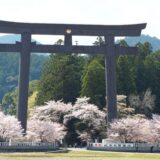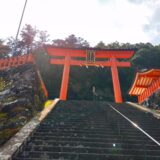【Kumano Hongu Taisha Shrine summary】
Kumano Hongu Taisha is the head shrine of the 3,000 Kumano shrines enshrining the Kumano deities. Kumano Hongu Taisha, Kumano Hayatama Taisha, and Kumano Nachi Taisha are collectively known as Kumano Sanzan (the three mountains of Kumano), and it is official to visit them from this shrine. The three shrines are part of the UNESCO World Heritage Site “Sacred Sites and Pilgrimage Routes in the Kii Mountain Range. Kumano Hongu Taisha enshrines the deity Ketomimiko-Ookami (also known as Kumanu-ni-Masu-Ookami, or Kumano-za-Ookami). The shrine was originally a place of training for Shugendo (mountain asceticism), and was established as a shrine by enshrining the deities at the site. The exact date of the shrine’s founding is unknown, but according to shrine records, it was built in 65 during the reign of Emperor Sojin on the upper reaches of the Kumano River.
![Kumano Hongu Taisha Shrine [Wakayama] kumano hongu taisha shrine jp4 1024x768 - Kumano Hongu Taisha Shrine [Wakayama]](https://japan-shrine.info/wp-content/uploads/kumano-hongu-taisha-shrine-jp4-1024x768.jpg)
Kumano’s deities were rooted in nature worship, but during the Nara and Heian periods, Kumano also became a sacred place for Buddhism, esoteric Buddhism, and Shugendo, and the belief that God = Buddha spread, and the three mountains, influenced by this belief, became more closely connected and began to worship the same 12 deities. In August of 1889, the middle four shrines and the lower four shrines were severely damaged by a flood, and many of the buildings were washed away. Miraculously, the four remaining shrines were relocated to the present location in 1891, and became the present Kumano Hongu Taisha.
【Kumano Hongu Taisha Shrine scenery】
![Kumano Hongu Taisha Shrine [Wakayama] DSC 0552 1024x768 - Kumano Hongu Taisha Shrine [Wakayama]](https://japan-shrine.info/wp-content/uploads/DSC_0552-1024x768.jpg)
Yatagarasu (three-legged crow) is depicted everywhere in the Kumano Hongu Taisha shrine, and even the masks of the guardian dogs have yatagarasu on them. The three legs represent heaven (God), earth (nature), and man (man), and they are said to represent the fact that they are brothers born of the sun.
![Kumano Hongu Taisha Shrine [Wakayama] DSC 0551 1024x768 - Kumano Hongu Taisha Shrine [Wakayama]](https://japan-shrine.info/wp-content/uploads/DSC_0551-1024x768.jpg)
After passing through the torii gate, dedicated Kumano Daigongen banners continue on both sides. After passing through the torii gate, 158 steps lead up to the main shrine, but the slope is not very steep.
![Kumano Hongu Taisha Shrine [Wakayama] DSC 0535 1024x653 - Kumano Hongu Taisha Shrine [Wakayama]](https://japan-shrine.info/wp-content/uploads/DSC_0535-1024x653.jpg)
The shrine gate is located at the top of the 158 steps. Passing through this gate, you will find yourself in the refreshing precincts surrounded by trees.
【Kumano Hongu Taisha Shrine precincts】
![Kumano Hongu Taisha Shrine [Wakayama] DSC 0543 2 1024x768 - Kumano Hongu Taisha Shrine [Wakayama]](https://japan-shrine.info/wp-content/uploads/DSC_0543_2-1024x768.jpg)
The Kumano-gongen-zukuri shrine pavilions, which were relocated from the four halls that escaped being washed away in the great flood of the Meiji period (1868-1912), have been beautifully restored with cypress bark roofs to commemorate the 120th anniversary of the shrine’s relocation to the present site. The main deity, Ietsumiko-no-okami, is said to have descended from a yew tree in the former shrine site of Osaibara, and is revered as the god of trees.
【Kumano Hongu Taisha Shrine Nearby attractions】
Kumano Hongu Taisha Otorii
【Kumano Hongu Taisha Shrine Access】
Manager’s Comments
This is the main shrine of my parents’ family’s Ujigami Shrine. It was an honor to visit the shrine. It was a sacred place, surrounded by beautiful and present mountains and a magnificent river. I would definitely like to visit the shrine again.
Motomiya, Motomiya-cho, Tanabe-shi, Wakayama 647-1731
Parking is available free of charge in the parking lot of the souvenir shop next to the Hongu Taisha shrine.
 Tour of Japanese shrines and temples
Tour of Japanese shrines and temples 

![Kumano Hongu Taisha Shrine [Wakayama] kumano hongu taisha oosaihara otorii jp1 520x300 - Kumano Hongu Taisha Shrine [Wakayama]](https://japan-shrine.info/wp-content/uploads/kumano-hongu-taisha-oosaihara-otorii-jp1-520x300.jpg)
![Kumano Hongu Taisha Shrine [Wakayama] DSC 0463 150x150 - Kumano Hongu Taisha Shrine [Wakayama]](https://japan-shrine.info/wp-content/uploads/DSC_0463-150x150.jpg)
![Kumano Hongu Taisha Shrine [Wakayama] kumano hongu taisha oosaihara otorii jp1 150x150 - Kumano Hongu Taisha Shrine [Wakayama]](https://japan-shrine.info/wp-content/uploads/kumano-hongu-taisha-oosaihara-otorii-jp1-150x150.jpg)
![Kumano Hongu Taisha Shrine [Wakayama] kumanonachitaisha1 150x150 - Kumano Hongu Taisha Shrine [Wakayama]](https://japan-shrine.info/wp-content/uploads/kumanonachitaisha1-150x150.jpg)
![Kumano Hongu Taisha Shrine [Wakayama] DSC 0581 150x150 - Kumano Hongu Taisha Shrine [Wakayama]](https://japan-shrine.info/wp-content/uploads/DSC_0581-150x150.jpg)

